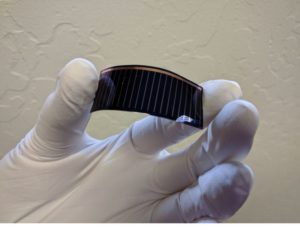 Alta Devices has a new place in the sun after garnering a contract from the Naval Research Laboratory for delivering light-weight solar drone technology.
Alta Devices has a new place in the sun after garnering a contract from the Naval Research Laboratory for delivering light-weight solar drone technology.
Alta’s Hybrid Tiger program will integrate research into a single drone system designed for long range endurance. The program deploys high-efficiency flexible solar cells, a hydrogen fuel cell, and energy-aware guidance algorithms and is sponsored by the Office of the Deputy Assistant Secretary of Defense for Operational Energy and the U. S. Marine Corps Expeditionary Energy Office.
“Widespread use of small UAVs in both the military and industry has been limited to-date by endurance. The Hybrid Tiger will demonstrate that very long endurance flights, with sophisticated telemetry and capabilities, can be achieved with the inclusion of solar arrays,” said Jian Ding, Alta Devices CEO. “This project will open the door for many new solar powered UAV applications, and we look forward to achieving next generation breakthroughs via this cooperative effort.”
The Tiger drone will be featured in a multi-daily demonstration at higher latitudes to “highlight how extreme endurance UAV flight can be achieved using hybridization of solar photovoltaics, a hydrogen fuel cell, and autonomous soaring algorithms, regardless of latitude or time of year.”
Ion Tiger’s electric fuel cell propulsion system has the low noise and low signature of a battery-powered UAV, while taking advantage of hydrogen, a high-energy fuel. The 550-W (0.75-horsepower) fuel cell has about four times the efficiency of a comparable internal combustion engine.
The Ion Tiger flew for 26 hours in November 2009 while carrying a 5-pound payload using hydrogen compressed to 5000-psi in a carbon/aluminum pressure vessel. In May 2013, the same researchers at the U.S. Naval Research Laboratory flew their fuel cell powered Ion Tiger UAV for 48-hours and 1 minute on April 16-18 by using liquid hydrogen fuel in a new, NRL-developed, cryogenic fuel storage tank and delivery system.
Jason is a longstanding contributor to DroneLife with an avid interest in all things tech. He focuses on anti-drone technologies and the public safety sector; police, fire, and search and rescue.
Beginning his career as a journalist in 1996, Jason has since written and edited thousands of engaging news articles, blog posts, press releases and online content.
Email Jason
TWITTER:@JasonPReagan
Subscribe to DroneLife here.







[…] operations needed in flight, including transition from daytime, when the drone is powered by the solar array, to night-time, when the aircraft’s batteries are […]